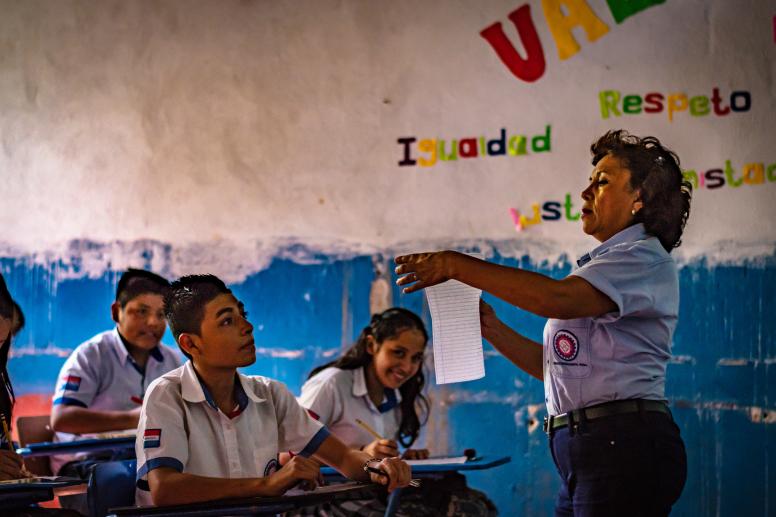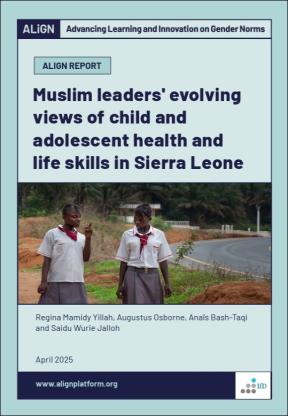
- Blog
- 5 décembre 2024
How can education systems help prevent gender-based violence?
- Author: Rachel Marcus
- Published by: ALIGN
The 16 Days of Activism spotlights the urgent need for action to combat gender-based violence. In this blog, Rachel Marcus outlines how education can challenge harmful gender norms, promote equality and foster respectful relationships.
A common response to high-profile cases of gender-based violence (GBV) is to call for schools to do more to challenge the misogynistic norms that underpin it. Schools are often seen as a strategic entry point for the response to the rise of ‘manfluencers’, some of whom condone male violence against women and girls, and who are increasingly popular among boys and young men.
Schools are responding: recent decades have seen the growth of innovative gender equality curricula and more specific GBV prevention programmes, with a focus on reaching adolescents. In Australia’s Victoria State, for example, the Respectful Relationships curriculum aims to help students learn how to build relationships to prevent family violence. And in London, primary schools are now offered resources and training to implement a healthy and respectful relationships curriculum. But what lessons can be learned from such programmes, and are they transferable across contexts?
ALIGN has published a study of how education systems can promote more gender-equitable values, particularly among boys, focusing on learning from the 'Global South'. This examines 19 initiatives, from small-scale pilot projects to state-level curricula and teacher training programmes.
Many of the programmes challenged ingrained gender norms about accepted gender roles and assumptions of male superiority and promoted more equal personal relationships. Some attempted to reduce students’ acceptance of GBV. Structured curricula helped students reflect on gender equality in their families and communities, recognise different forms of GBV and, in some cases, practice respectful communication and non-violent conflict resolution.


Programmes around the world are changing attitudes to GBV
Six evaluations in countries as diverse as Bangladesh, Cambodia, India, Pakistan and Panama, and of a multi-country programme in three African and two South-East Asian countries (Connect with Respect) measured the impact of programmes on attitudes to GBV. All found that participating students (boys and girls) became less accepting of physical, psychological or sexual violence than non-participants.
Two evaluations reported changed attitudes to intimate partner violence, as shown by a fall in the proportion of students who agreed that it is acceptable for a husband to beat a wife in some circumstances. Participants in a pilot programme in Panama reported it had helped them challenge existing gender norms. As one 15-year-old boy put it:
‘I was told in my family that men have to be strong and violent, that it is our nature as men. But I know now that I do not need to be violent.’
Participant in Me & My New World programme, Panama
But are these programmes changing behaviour?
Changes in attitudes triggered by such programmes do not always result in changes in behaviour, particularly where this means going against the perceived norms among family, friends or influential community figures. Further, evaluations of such programmes are often carried out soon after they end, and adolescents might not have had a chance to act on their new learning. As a result, some studies measure changes in intended behaviour instead of actual behaviour. For example, the evaluation of an initiative in two Indian states found participating students were more likely to report that they would take action against sexual harassment or physical violence if they witnessed it.
However, we did also find evidence of behaviour change. A six-week gender-based violence prevention programme for high-school-age boys in Kenya significantly increased the likelihood of participants intervening to stop a violent incident or threat of sexual harassment. Another evaluation of a programme in Bangladesh resulted in a higher proportion of students demonstrating non-violent behaviour and with skills in alternatives to GBV, such as communication, empathy and managing emotions.
‘Before the workshop we used to beat them – now we do not beat girls anymore. When I am provoked in class by girls, I just report the matter to the teacher.’
Participant in HERO Empathy programme, South Africa
While many programmes had positive impacts on attitudes, not all resulted in immediate or widespread changes. For example, one study found that even after a programme lasting most of a school year, almost 40% of students still considered wife-beating acceptable. This may reflect how ingrained the norms underpinning GBV are in some of the contexts where these school-based programmes have been implemented.


What approaches make it more likely gender-transformative education will help to reduce GBV?
Our research suggests that some effective practices to help shift both attitudes and behaviour include:
An explicit focus on GBV. Curricula and programmes with such a focus helped students to understand what constitutes GBV and to ‘de-normalise it’.
Showing how GBV is underpinned by broader gender inequalities. Effective programmes helped students understand how norms that support male dominance contribute to an environment where GBV can flourish. They linked the need to tackle gender differences in educational and work opportunities and male dominance in decision-making and public spaces to create an environment free from GBV. Examples include: the HERO Empathy programme in South Africa and the GEMS programme, which originated in India and was later introduced in Bangladesh and Viet Nam.
Tailoring curricula, learning materials and teaching to context. Effective courses often focused on the most pressing local manifestations of GBV. This might be forced child marriage, the risk of sexual assault while travelling to school or at school, or the violence children see and experience in their homes. Teachers may need support to tailor their teaching to local contexts, particularly if they are not originally from the local area.
‘We can’t go into a child’s community and say ‘Look, what you’re doing is violent’. But we can tell them, ‘There are various things that we do that are violent, and we have also received violence from other people’. When they begin to see or understand each type of violence, they begin to think more about their actions.’
Practitioner, SERNiña, Guatemala
Participatory learning strategies and space to reflect on values and experiences. Effective programmes created space for students to reflect on gender stereotypes and roles in their families, communities and peer groups. They often included participatory activities, such as role play, games and projects, which brought learning to life and enabled students to use new skills – such as respectful communication.
Training and support for teachers. The most effective initiatives provided teachers with good quality and ongoing training and support. This enabled them to reflect on gender biases in society, and helped them develop tools and strategies to challenge gender-inequitable attitudes and behaviour. Ongoing support for teachers was also vital, whether through peer learning communities, more formal mentoring or refresher courses.
Taking a ’whole school approach’. This means building gender equality and violence prevention values into school practices and structures, including avoiding gender stereotyping, emphasising respectful behaviour, and creating effective mechanisms to respond to violence. It also means ensuring that all staff and governance bodies are on board, with everyone working to eradicate GBV in their schools, and outreach to parents to reinforce the messages received at school.


What is needed to take these approaches to scale?
First, work with school systems to integrate content on gender equality into school curricula at national and state level. This involves developing learning materials that embed content into existing subjects (e.g. life skills, citizenship, history or languages), and guidance for teachers on their use. Making gender equality content examinable may also help to prioritise these topics.
Second, take a phased approach to build up delivery capacity in the education system. This means integrating new content into teacher pre-service education and in-service training. It also involves developing capacity to support and monitor implementation – a task that takes several years, and often means that programmes need to be progressively rolled out until full coverage is reached.
Third, create long-term, cross-government ownership and commitment to gender equality curricula. Implementing and sustaining these systems needs political leadership, as resources are needed for 10–15 years or longer. Cross-governmental and cross political party buy-in is essential to ensure initiatives are not reversed following a change of government. And in low-income countries, it requires enhanced and long-term funding from international donors.
And finally, communicate pro-actively about programmes’ aims to prevent myths and misinformation. School programmes that challenge GBV are easily misrepresented. Clear communication about their aims can stop misinformation undermining programmes that benefit the children who take part, while also helping to build safer, fairer societies.


About the author - Rachel Marcus
Rachel Marcus is a social development researcher and practitioner who focuses on social equality, particularly related to gender, childhood, adolescence and youth. In recent years she has led research on gender and school environments, girls’ clubs, working with boys to promote gender-sensitive masculinities, and gender-sensitive youth livelihood programmes.
- Tags:
- Education, Gender-based violence
- Countries / Regions:
- Global
Related resources
Report
13 novembre 2024

Published by: ALIGN
Report
8 septembre 2024

Blog
14 avril 2025

Report
14 avril 2025

Report
26 mars 2025
